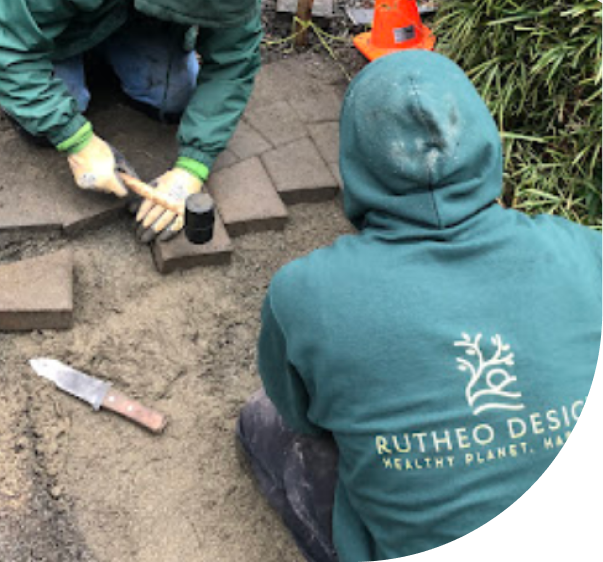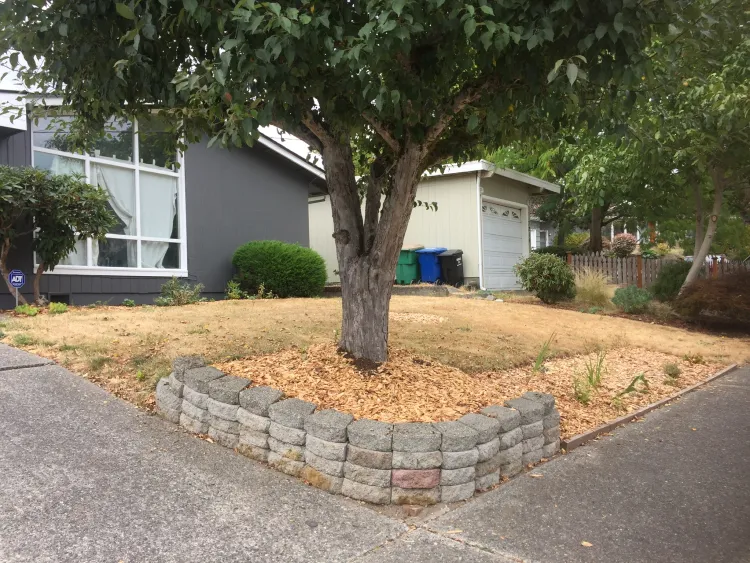
At Rutheo Designs, we see weeding and mulching as key to building resilient, low-maintenance landscapes. In Seattle’s climate, we use non-toxic, soil-friendly methods to control weeds—like hand removal and organic spot treatments—to protect your plantings and support healthy soil.
Mulching is more than weed suppression. It conserves moisture, regulates soil temperature, prevents erosion, and feeds soil life. We use locally sourced materials like wood chips, compost, or straw, tailored to your garden’s needs and the season. Together, thoughtful weeding and mulching create a strong foundation for sustainable landscape health.
At Rutheo Designs, we emphasize practices that promote long-term ecological balance, low-maintenance planting, and soil health. Two of the most foundational strategies in sustainable landscaping are weeding and mulching. When applied with intention and timing, both significantly reduce labor, support biodiversity, and maintain vibrant, healthy plant systems.
Weeds are not just aesthetic nuisances—they directly compete with desired plants for moisture, nutrients, and light. In a densely planted bed, they can quickly outcompete slower-growing perennials or native shrubs, especially during early growth stages. This competition is intensified in nutrient-poor soils or during dry spells, common in late Seattle summers.
In addition to surface competition, weeds interfere underground. Aggressive root systems like those of bindweed or horsetail tangle with the roots of ornamental and native plants. This restricts access to essential nutrients and oxygen and can physically push out less vigorous plants in confined garden spaces.
Seattle’s temperate climate encourages rapid spread of invasive species such as bindweed, shotweed, and Himalayan blackberry. These plants adapt quickly, thrive in disturbed soils, and reproduce with high efficiency, both vegetatively and by seed.
Unchecked, these invasive species displace native plants, alter soil composition, and degrade wildlife habitat. Himalayan blackberry, for instance, forms dense thickets that crowd out low-growing groundcovers and prevent native understory plants from establishing, which disrupts food chains and pollinator systems.
Removing weeds in early spring before they set seed or develop deep root systems reduces labor demands through the growing season. This proactive step is one of the most cost-effective approaches to long-term garden management.
Every mature weed left to flower increases the seed bank pressure in the soil. Many seeds, such as those from shotweed or dandelion, can remain viable for years. Routine removal before flowering helps prevent future outbreaks and keeps the weed population manageable over time.
We prioritize non-chemical, hands-on weeding methods. Depending on the weed type and growth stage, different tools perform better. Hori hori knives, loopers, and long-handled forks are among the most effective tools for lifting roots without breaking them, especially in clay-heavy Seattle soils.
Soil structure and microbial activity are critical in sustainable landscapes. When we remove weeds, we take care not to disturb the soil microbiome. For shallow-rooted annual weeds, surface slicing with a sharp blade avoids unnecessary soil turnover. For deeper perennials, we gently loosen the soil around the root zone to preserve fungal networks and earthworm tunnels.
One of mulch’s core functions is acting as a physical barrier. A well-applied mulch layer blocks sunlight, denying weed seeds the conditions needed to germinate. At the same time, mulch helps retain soil moisture—particularly valuable during Seattle’s summer dry spells.
We recommend a mulch depth of 2 to 4 inches, depending on the plant community and soil type. Mulch should be applied evenly, avoiding direct contact with stems or trunks, which can cause rot. For suppression, it’s most effective to mulch after thorough weeding and before peak germination periods.
Combining mulch types can increase suppression and ecological value. For example, using composted bark beneath a layer of arborist wood chips offers both immediate weed blocking and longer-term nutrient release. This mimics forest floor layering and supports healthy decomposition cycles.
Spring is the ideal time to remove overwintered weeds and apply mulch to warm the soil. Early action prevents spring weed seed set and helps perennials push through the soil with fewer competitors. We focus on timing applications after initial weeding but before peak growth begins.
In summer, mulching becomes a defense against soil dehydration. Drought conditions are increasingly common in the Pacific Northwest, and maintaining mulch coverage helps reduce irrigation needs. We often top up mulch layers in July to outcompete heat-loving weeds like purslane and spurge.
In fall, we use mulch to rebuild soil health and prepare beds for winter. Leaf mulch, straw, and compost insulate soil microbes and prevent erosion during the rainy season. Cutting back weed growth before dormancy helps reduce seed carryover into the next season.
While most growth slows, winter weeds can still gain a foothold. In food beds or bare patches, we recommend living mulches or cover crops like clover or winter rye. These reduce erosion, limit weed germination, and add organic matter when terminated in spring.

At Rutheo Designs, we are dedicated to transforming your outdoor spaces into beautiful, sustainable landscapes that reflect your vision and the unique character of the Seattle area. Whether you’re looking to enhance your garden with native plants, need expert advice on water-efficient irrigation systems, want to explore custom hardscaping for your outdoor living space, or discuss a comprehensive landscape design, our team is here to assist you every step of the way. We offer services in native plant landscaping, water-efficient irrigation, custom landscape design, and hardscaping solutions tailored to your goals and the local environment. Every project is unique, and we take the time to listen to your needs and offer personalized solutions that align with both your aspirations and Seattle’s natural surroundings.
We invite you to reach out to us to start the conversation about your landscaping needs. You can contact us by email at connect@rutheodesigns.com or give us a call at (360) 844-2989. Whether you have specific questions or are ready to schedule a consultation, we’re eager to help you bring your outdoor vision to life with the care and expertise that Rutheo Designs is known for.